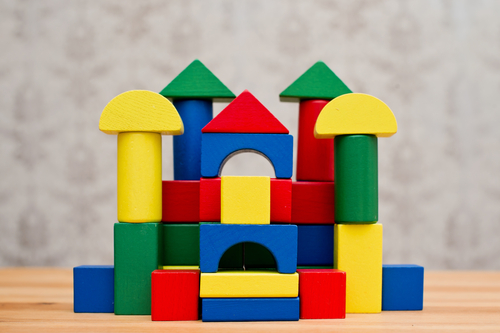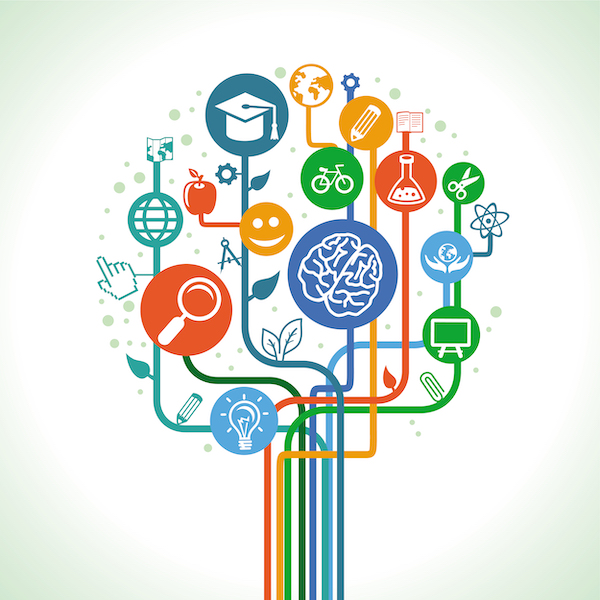Building Blocks: How Kids Learn Through Play

Building blocks are a great way for kids to have awesome fun! Kids can use building blocks to create whatever their imagination can come up with. They can build towers, castles, houses, robots, and anything else they can think of. Building blocks can also be used to teach kids about shapes, colors, and sizes.
Building blocks can also be used for problem solving. Kids can use the blocks to figure out how to build something or how to solve a problem. This can help them develop their problem solving skills.
Building blocks can also be used to teach kids about physics. Kids can use the blocks to create structures and experiment with how they balance and move. This can help them learn about the laws of physics and how things work.
Finally, building blocks can be used to help kids develop their motor skills. Kids can use the blocks to practice their hand-eye coordination and fine motor skills. This can help them develop the skills they need to be successful in school and in life.
Building blocks are a great way for kids to have awesome fun. They can use them to create, problem solve, learn about physics, and develop their motor skills. Building blocks can help kids learn and grow in a fun and engaging way.
Ideas of what you can build
Building blocks are a great way to encourage creative play. Here are some ideas for how to use building blocks in creative play:
1. Create a city: Have your child build a city using the blocks. They can create roads, buildings, and even people.
2. Make a castle: Have your child build a castle using the blocks. They can create towers, walls, and even a moat.
3. Create a bridge: Have your child build a bridge using the blocks. They can create a bridge that spans a river or a ravine.
4. Build a spaceship: Have your child build a spaceship using the blocks. They can create a cockpit, engines, and even a launch pad.
5. Construct a robot: Have your child build a robot using the blocks. They can create a body, arms, and even a head.
6. Design a house: Have your child build a house using the blocks. They can create walls, windows, and even a roof.
7. Construct a vehicle: Have your child build a vehicle using the blocks. They can create a car, truck, or even a train.
8. Make a sculpture: Have your child build a sculpture using the blocks. They can create a figure, animal, or even an abstract design.
Types of building blocks
Plastic Building Blocks: Plastic building blocks are a classic choice for kids of all ages. They are durable, lightweight, and come in a variety of shapes and sizes. Plastic building blocks are a great way to encourage creativity and problem-solving skills in children.
Wooden Building Blocks: Wooden building blocks are a classic choice for kids of all ages. They are heavier than plastic blocks, but they are also more durable and have a classic look and feel. Wooden building blocks are great for encouraging children to use their imagination and develop their fine motor skills.
Foam Building Blocks: Foam building blocks are a great choice for younger children. They are lightweight, soft, and come in a variety of shapes and sizes. Foam building blocks are a great way to encourage children to use their imagination and develop their fine motor skills.
Cardboard Building Blocks: Cardboard building blocks are a great choice for younger children. They are lightweight, durable, and come in a variety of shapes and sizes. Cardboard building blocks are a great way to encourage children to use their imagination and develop their fine motor skills.
Plastic Building Blocks
Plastic: LEGO, Mega Bloks, K'Nex, KRE-O, Best-Lock
LEGO is the most popular building block toy on the market. It is a classic, and has been around for decades. It is known for its interlocking pieces and its wide variety of sets. LEGO sets come in many different themes, from Star Wars to Harry Potter to City. LEGO pieces are also compatible with other LEGO sets, allowing for endless possibilities.
Mega Bloks are similar to LEGO, but are slightly smaller in size. They are also compatible with LEGO pieces, and come in a variety of themes. Mega Bloks sets are often more affordable than LEGO sets, making them a great option for those on a budget.
K'Nex is a building block system that uses rods and connectors to create 3D structures. K'Nex pieces are larger than LEGO and Mega Bloks pieces, making them easier to handle for younger kids. K'Nex sets come in a variety of themes, from dinosaurs to roller coasters.
KRE-O is a building block system from Hasbro. KRE-O pieces are compatible with LEGO and Mega Bloks pieces, making them a great option for those who want to mix and match sets. KRE-O sets come in a variety of themes, from Transformers to My Little Pony.
Best-Lock is a building block system that is similar to LEGO and Mega Bloks. Best-Lock pieces are slightly larger than LEGO and Mega Bloks pieces, making them easier to handle for younger kids. Best-Lock sets come in a variety of themes, from pirates to construction sites.
Magnetic Building Blocks
Magformers are a type of building blocks that use magnetic pieces to create 3D structures. The pieces are made of high-quality ABS plastic and feature powerful magnets that allow them to snap together easily. The pieces come in a variety of shapes and sizes, allowing for endless possibilities when it comes to building. Magformers are great for developing problem-solving skills, as well as creativity and spatial reasoning. They are also a great way to introduce children to the basics of engineering and architecture. With Magformers, the possibilities are endless, and the fun never stops.
Wood Building Blocks
Quercetti building blocks are a great way to encourage creative play and problem-solving skills in children. Made from high-quality wood, these blocks are designed to be durable and long-lasting. They come in a variety of shapes and sizes, allowing children to explore their imaginations and build whatever they can dream up. The blocks are also great for teaching basic math and engineering concepts, as well as helping children develop fine motor skills. With Quercetti building blocks, children can create anything from castles to robots and more.
Plastic Large Bricks
Sluban is a brand of building blocks that are made from plastic and bricks. The blocks are compatible with other major brands of building blocks, such as Lego, and come in a variety of shapes and sizes. Sluban blocks are designed to be durable and easy to use, and they come in a variety of colors and styles. The blocks are also designed to be easy to assemble and disassemble, making them great for creative play. Sluban blocks are a great way to encourage children to explore their creative side, as they can be used to build anything from castles to robots. They are also a great way to teach children about engineering and construction, as they can be used to build bridges, towers, and other structures. Sluban blocks are a great way to get children interested in building and engineering, and they are sure to provide hours of fun and learning.
Plastic Micro Bricks
Nanoblock is a type of building block that is made of plastic and is much smaller than traditional building blocks. These blocks are often referred to as micro-bricks or nanoblocks and are designed to be used to create intricate and detailed models. The blocks are typically around 4mm in size and are made of a durable plastic that is designed to withstand the rigors of building and playing. The blocks come in a variety of colors and sizes, allowing for a wide range of creative possibilities. Nanoblock sets come with instructions and pieces to build a variety of models, from animals to buildings to vehicles.
Nanoblock is a great way to introduce children to the world of building and engineering. The blocks are small enough that they can be used to create detailed models, but are still large enough for children to manipulate and build with. The blocks are also durable and can withstand the wear and tear of playtime. Nanoblock sets come with instructions, so children can learn how to build the models and gain an understanding of how the pieces fit together.
Nanoblock is a great way to encourage creativity and problem-solving skills in children. The blocks can be used to create a variety of models, allowing children to explore their creative side. The blocks also help children learn how to plan and build, as they must figure out how to fit the pieces together to create the desired model. Nanoblock is a great way to introduce children to the world of building and engineering, and can help them develop important skills.
Light-Up Brick
Laser Pegs are a unique type of building blocks that light up when connected together. They are made up of small plastic bricks that have LED lights inside them. The bricks come in a variety of colors and shapes, allowing for endless possibilities when it comes to building and creating. The pieces are easy to connect and disconnect, making them perfect for younger children who are just starting to explore the world of building blocks. With Laser Pegs, kids can create anything from a simple house to a complex spaceship. The light-up feature adds a fun and exciting element to the building experience, and the pieces are durable enough to withstand hours of play. Laser Pegs are a great way to encourage creative thinking and problem-solving skills in children.
Other Brands for further research
Foam blocks: Foamnasium, ECR4Kids, Edushape, Melissa & Doug, Gonge, SoftTiles, WonderFoam, Imagination Generation, Learning Resources, Fat Brain Toys
Cardboard blocks: Imagination Generation, ECR4Kids, Melissa & Doug, Learning Resources, Fat Brain Toys, Gonge, Constructive Playthings, Guidecraft, Kapla, PlanTo
Plastic blocks: LEGO, Mega Bloks, K'Nex, Magformers, KRE-O, Quercetti, Sluban, Nanoblock, Best-Lock, Laser Pegs
Wooden blocks: LEGO, Lincoln Logs, Tinker Toys, Playmobil, Duplo, Magformers, KRE-O, Quercetti, Sluban, Nanoblock, Best-Lock, Laser Pegs, Imagination Generation, Cobi, ZOOB, Haba, BanBao, Strictly Briks
How Building blocks help children develop
Building blocks are an essential part of a child’s development. They provide an opportunity for children to explore and learn in a fun and engaging way. Building blocks can help children develop cognitive, social, motor, and language skills.
Cognitive skills are the foundation for learning. Building blocks can help children develop their cognitive skills by allowing them to explore and experiment with different shapes and sizes. This helps them to develop problem-solving skills, as well as their ability to think logically and reason.
Social skills are also important for children to develop. Building blocks can help children learn how to interact with others and understand their feelings. They can also help children learn how to cooperate and work together in a team.
Motor skills are essential for children to develop. Building blocks can help children develop their motor skills by allowing them to practice fine motor skills such as grasping, manipulating, and constructing. This helps them to develop their hand-eye coordination and balance.
Language skills are also important for children to develop. Building blocks can help children to develop their language skills by allowing them to practice their vocabulary and sentence structure. This helps them to understand and communicate with others.
In conclusion, building blocks are an essential part of a child’s development. They provide an opportunity for children to explore and learn in a fun and engaging way. Building blocks can help children develop cognitive, social, motor, and language skills.


